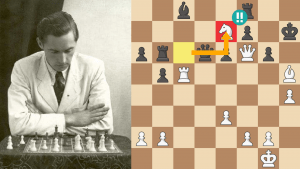
To Sacrifice Or Not To Sacrifice, That Is The Question
NinjaSocks123 asked:
I’m currently reading How to Reassess Your Chess 4th edition and I’m currently on chapter four. You keep talking about weighing both sides’ imbalances (including material) to figure out if a sacrifice is good, but how do I know if I get adequate compensation? Is there a concrete way to determine the value of the different imbalances or does it depend on the situation? Thank you in advance!
JS: That’s a huge chapter (Psychological Meanderings — about 90 pages), but I guess you’re referring Material/Fear of Giving Up or Taking Material.
So, how do you know if you get adequate compensation if you sacrifice something?
Sorry, there is no guarantee. You calculate a tactical sequence that has you sacrificing a piece; it might or might not work, depending on your ability to calculate deeply. And the dice will fall one way or the other. However, you have to have faith in what you’re doing and if the opponent finds a refutation then fair enough. Shake hands and try again another day.
Keep in mind that even grandmasters sacrifice only to find that their hoped-for compensation has, magically, vanished before their very eyes.
Fortunately, most players can’t defend well. And amateurs tend to wilt in the face of an enemy attack. So if you do sacrifice for an attack or positional superiority, the odds are on your side.
But, if you want something that will tell you to do it or not, the best option is to (right before you do the sacrifice!) make an internal list of what you’re getting for the lost material.
Here’s a clear example:
Note that when you make a sacrifice you need to be able to list (internally!) what you’re getting for the material. In this case it was easy: White sacrificed a bishop for two pawns, got a nice initiative, got monster center pawns that were threatening to march down the board and, in some lines, crack open Black’s kingside (via e4-e5-e6).
All that seemed to be enough so I decided to have some fun and go for it.

If you can’t list what you’re getting then don’t do it! And if you are sacrificing for a mere check or a momentary threat, don’t do it.
Here’s another example of me taking a calculated risk:
The final position in that game was interesting:
In the next game I was under the gun:
In the Gilden game the inaccurate attacker (Black) managed to survive, even though in this game White should have won. The reason why Black stayed alive: when you are attacking and every move can mean life and death, the defender often cracks. In other words, it’s very hard to defend, and even if your opponent is defending like Capablanca, nerves and exhaustion will still give you chances.
Here’s our last sacrifice, but this time it was (by far) the best way to handle the position:
If you find that you have a list that’s even close to that, don’t hesitate to toss the pawn away, sit back, and enjoy the ride.






